Don't wanna be here? Send us removal request.
Text
I really enjoyed this blog post and the different points about graffiti’s positive impacts on society that you shed light on. In this post you tied together a lot of the concepts that we talked about in class and intertwined it with your own opinions and experiences.
I agree completely that graffiti and street art is a way to bring people together, and I thought it was interesting how you tied it into our class and how it can be as far-reaching as to be a subject that all of us with different backgrounds, interests and lives share to learn about.
I like that you mentioned how even the graffiti that can be considered vandalism can bring people together as a group will work together and better their community by cleaning it up. Since there is a pretty even ratio between vulgar graffiti and street art, it is important to also recognize that the negative graffiti can also have a positive impact on society in some way.
Without this class, I don’t think that many of us would understand graffiti on this level or take the time to really consider its impacts on our society unless we were directly affected by it. Do you think that this is something that should change in our society? Should there be more conversations about graffiti and street art and its impacts? How might we be able to start a conversation like this?
Blog Prompt 8
Based on what I’ve learnt in this course over the past semester, including topics such as the meanings and many interpretations of informal public art, we covered a variety of ways which street art can impact society. An example of this could be the positives that actually result from graffiti art. There are many negative opinions and perspectives surrounding this type of art due to the negative stigma of it simply just being vandalism that has been around for so long, but really there is more that must be paid attention to. As I have mentioned in my previous blog prompt posts, street art is often used as a platform for individuals to voice the political and societal opinions they they may have. Ranging from Gay Rights, to feminism, even to issues such as eating disorders art of this nature often has important underlying messages that the artist feels the public should pay more attention to. Even though some of the negative opinions of graffiti just being vandalism may be true when it comes to tags for example, there is no need to forget or discredit the beauty and precision that comes from graffiti, murals. Street art now, is typically a more unique and modern technique that people use as a call to action or form of self expression that I personally find interesting and beautiful as long as it is not gruesome and vulgar. Anywhere I go I look for small forms of street art and enjoy pondering the meaning behind it and the artist who created it.
I feel that there are many ways it can be used for the betterment of society. The most prominent way it can be used, is as a tool that has the ability to bring people from all walks of life together. Regardless if this means it is artists coming together to create something wonderful, people like us with an interest in it coming together to learn and appreciate, or volunteers in the community working together to clean up and create a more ‘pleasant’ or family friendly space to live, this is what graffiti has the power to do. To further analyze this, think about out class. Many of us come from different cities, with different backgrounds and from different cultures, but we all share one unique interest in street art and are working to learn more. When artists come together to collectively use their talents to produce something, more often than not something amazing is created. When the community appreciates things like this, events such as the Guelph Jazz festival acknowledge it and create walks and tours that draw attention to the uniqueness and special characteristics in a city. In toronto, graffiti alley is a tourist attraction as well. Accepting and allowing for this like this to happen can draw in more working people that can contribute to not only the increasing community value, but now the economic value as well. NOt only that but when volunteers come together to clean up old graffiti that may not be as nice, they are networking and creating a more beautiful space for the community. It allows for a nicer place for kids to play and families to be together without having to worry about ‘safe areas�� because everywhere has the same appearance and value.
In total, I believe that the pros to graffiti outweigh the cons and I will continue to appreciate the art that I see, only now with a more critical eye. I am thankful for the information that I have learned and the opportunities presented to me that have furthered my interest in this art form.
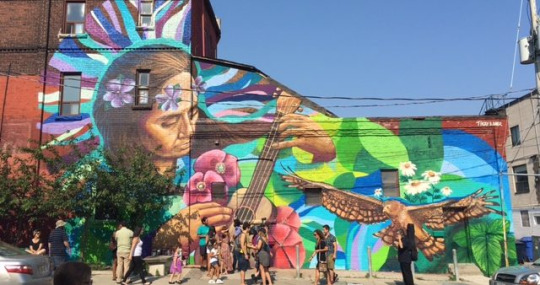
2 notes
·
View notes
Text
Impact of Graffiti and UNIV*1200
UNIV*1200 has opened my eyes to a side of graffiti to an extent that I likely would have never discovered on my own. It has taught me to consider how it can be used in a way that extends much further than the basic vandalism the term ‘graffiti’ is normally associated with, and how it can positively impact society.
To start off, I think it is important to note how art in general can bring value to a community. If you have the time, you should watch the following video. The video touches upon how art impacts a society by providing people with a way to express themselves, make social changes, connect and better understand one another, and to tell their stories.
youtube
https://www.youtube.com/watch?v=cHJUhuiqmU0&feature=youtu.be
One line that particularly stood out to me as I felt that it ties into graffiti was by Ghassan Salamé; “We should protect artists by not defining their role. By giving him the margin he defines for himself for his creativity.”
I think that people can often expect artists to work within certain boundaries, but they should be able to express themselves through whichever means allow them to be most creative, which may include graffiti. If this is the method that the artist chooses to use to share their work, why should we deny them of that?
Artists using graffiti provides them with a platform to share their message with a much larger and more diverse audience, as it is available for all people passing by to see and appreciate. The artist likely had their own personal ideas and inspiration behind the piece, but due to the anonymous nature of graffiti, the viewers will never really know what that may be. This allows the audience to think about what that meaning may be, or reflect upon it and relate it to their own lives. This could provide a completely different experience than it would for a formal art piece whose background is known, and could have a profound impact on their lives without the artist even knowing it.
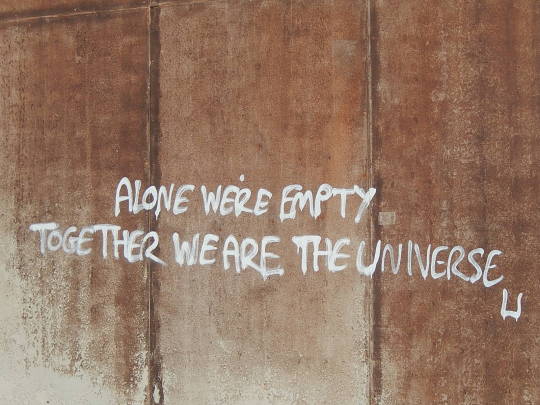
(Image from https://www.flickr.com/photos/mikecogh/9737685677)
Another way that graffiti benefits society is that it provides the artists with a positive way of expressing their thoughts and emotions. Mental health issues are prevalent wherever you go, and I think many of these issues can root from people not having effective coping mechanisms to deal with negative feelings. Graffiti can allow people to share their stories and express their feelings in a creative way. Without graffiti, these artists may not have the means to do this, and this could result in much more detrimental effects on a society than those that may be related to street art.
Similar to almost any other topic, it is easy to focus on the negative impacts that graffiti can cause in a society. It doesn’t take much effort to see graffiti and instantly classify it as vandalism, regardless of its content. Considering how common street art has become in cities across the world, it is important to acknowledge how it can better a society by providing visual variety, a way to communicate important ideas, and bring people together. When you take into account the benefits you can see that for most graffiti, the good outweighs the bad, and it can prove to be an essential part of society.
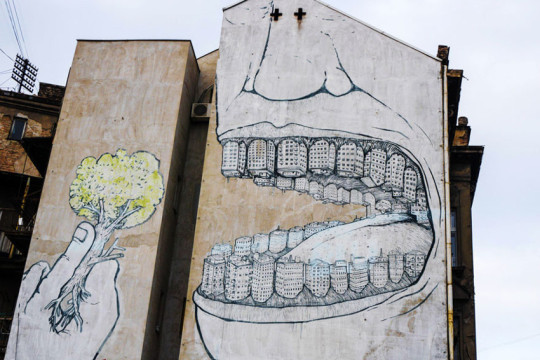
(Image from https://en.fishki.net/1500133-36-powerful-street-art-pieces-that-tell-the-uncomfortable-truth.html)
1 note
·
View note
Text
Hey Rikki!
I agree with many of the points you mentioned in your post.
There definitely needs to be a compromise made between the people who benefit from graffiti and those who are harmed by it.
I also think that a volunteer group would be the best way to manage this issue. If this were done based on donations, I think it would appeal to both sides of the argument as the people who disagree with graffiti may want to contribute to its removal altogether, and street artists or those who support it may want to donate to remove tags or poorly done graffiti and support those who are doing well done graffiti.
What you mentioned about commissioning artists to do murals on the walls resonated with me because of how Shelley, the owner of the Red Brick Cafe, mentioned it changed the way her building was tagged. Once she had the commissioned pieces up, her building was no longer tagged. Maybe if this were to be done in more public areas, the same result would happen in the city.
Prompt 7: A Middle-Ground for Addressing Graffiti
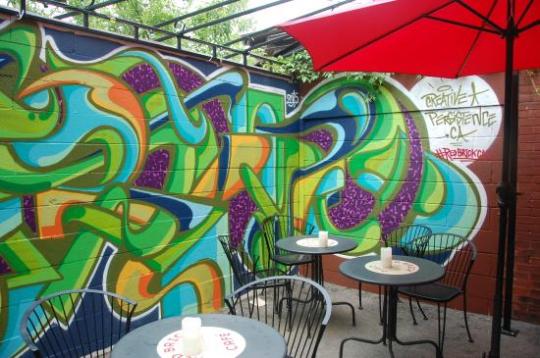
(Art at the Red Brick Cafe in Guelph. Image found at https://www.tripadvisor.ca/LocationPhotoDirectLink-g154989-d2341620-i134946480-Red_Brick_Cafe-Guelph_Ontario.html )
Because graffiti and street art can be so many different things, and mean so many different things to different people, I don’t think there is one clear-cut way of dealing with graffiti in a community. It is the nature of people that we all have different opinions on things, and often people feel very strongly about their opinions. Because of this, no matter how graffiti is addressed someone is always going to be unhappy.
If we address graffiti as a serious problem that needs to be removed altogether, it would upset street artists, graffiti writers, and everyone else who benefits from or enjoys graffiti. Similarly, by claiming that all graffiti is good and should be allowed to remain anywhere it is put, we are ignoring everyone who is harmed by graffiti and by the effects graffiti has on an area, such as small business owners.
The only real solution would be to look for the best possible compromise between the two that is also realistic and cost-effective. A volunteer group similar to the one we learned about in class, that covers up graffiti around cities, would be a great way to tackle the removal of graffiti. If the groups were larger scale, perhaps with some funding from the government and/or donations, they could become more widely available in different cities and areas.
The decision whether or not to remove graffiti should be up to the business owner of the building a given piece is on. Ultimately, the building belongs to the business owner, and whether there is graffiti on it should be up to them. The business owners would be responsible for deciding to get rid of it, but the actual removal would be up to the groups of volunteers.
The obvious exception to this, I would say, would be offensive graffiti. Graffiti that is vulgar, offensive, or attacks minorities should be removed without question, as soon as possible. I believe this responsibility should fall on the police, much like it does now. Currently, especially offensive pieces of graffiti are removed quickly by the police, and I think that absolutely makes sense.
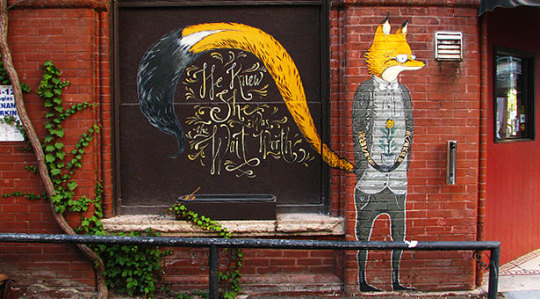
(Commissioned art at the Red Brick Cafe in Guelph. Image found at http://redbrickcafe.ca/info/art-showings/art-info-1/ )
Finally, we have talked a bit in class about the increasing frequency of people using informal public art to discourage “lower quality” graffiti. Commissioning artists to cover a particularly appealing wall in the eyes of graffiti writers with a mural or other artwork discourages people from tagging the wall or otherwise defacing it, and oftentimes it seems to attract people who are interested in seeing the nice artwork.
Not only that, but it also creates the opportunity for street artists to do what they love and create art they can be proud of, that will be on display for people to appreciate. This creates more of a demand for people with informal public art skills, helps change the stigma behind street artists, and reduces the amount of tagging and poor-quality graffiti being done around cities.
By encouraging the use of murals and public artwork to prevent unwanted graffiti, we could create a much nicer look for areas than poorly covered-up patches on walls, encourage people to visit areas with nice art to look at, change the stigma behind informal public art, and create a job market for street artists looking to express themselves.
3 notes
·
View notes
Text
Dealing with the Grey Areas
Addressing the topic of graffiti within communities proves to be controversial, as many citizens tend to have conflicting opinions towards it.
On one hand, there are those who enjoy seeing graffiti in their city and feel as though it contributes positively to the area where it is found. Conversely, many people view it solely as vandalism, and would prefer that it is eradicated altogether. Essentially, these outlooks boil down to those who identify graffiti as street art, and those who perceive it as vandalism.
Finding a compromise between both sides of the argument may prove to be a challenge, but I believe that there could be a solution that citizens could agree upon.

(Image from https://www.futurelearn.com/courses/art-crime/0/steps/11888)
In regards to what graffiti should be removed within a city, I think that this really depends on its content. I think that if it is offensive or hateful by any means, it needs to be removed.
I do not necessarily believe that all tags or simply poorly-done, visually displeasing graffiti warrant removal, however this depends on on their location and the budget of the removal. For example, if a tag was found on a business owner’s property and they did not want it there, it should be removed. If the same piece was found on public property, it may not be a great enough issue to spend time, money and resources to remove it.
If the piece is visually appealing, or has a positive message and thought put into it, I think if the location of the piece is suitable, it should remain there as it does not have a negative impact on the city.

(Image from https://www.widewalls.ch/is-graffiti-art-or-vandalism/)
I believe that for property owners who are strongly against any forms of graffiti being placed on their walls, it is their responsibility to pay for it to be removed.
If there is not already graffiti on their walls, they could apply a barrier coating to their walls. Barrier coatings are clear coatings which lead to extremely easy cleanup of graffiti, and are typically cost-friendly and safe to use. When applied, graffiti can be removed by high pressure rinse of hot water on the walls (https://www.reliableplant.com/Read/8967/graffiti).
Though this would still require time, money and energy, it would use a lot less by preventing the graffiti rather than removing it after it is already there.

(Image from https://www.sherwin-williams.com/painting-contractors/business-builders/paint-technology-and-application/sw-article-pro-antigraffiticoa)
For public areas, I believe that if the graffiti is to be removed, it should be funded by the city’s municipal government. In order to minimize the costs, there could be a committee in charge of the removal that allows those who need to obtain community service or volunteer hours to dedicate their time to removing it. By regulating the graffiti through volunteers, the budget for removing the graffiti would only need to be spent on the products required to do so, as the actual process would be done by volunteers.
2 notes
·
View notes
Text
Hey Dante!
I really enjoyed your post and agreed with a lot of the points that you mentioned.
Before taking this class I also did not really see a point of people doing graffiti as I thought there were many better ways for artists to show their work or to spread a message that were more permanent and less controversial.
I agree that it is a good way for people to be heard through art because being in a public space it is available for a lot more people to see and reflect on the messages. I also think that it opens the art to a different demographic of people that likely would never see it if it weren’t out in the open.
I also agree that after taking this course it is easier to see the different perspectives of graffiti, especially after hearing from the guest speakers that were on opposite sides of the debate. It also has made it easier to notice the graffiti, and leads you to think more deeply about it than ignoring it and just walking past it.
My Mind
At the beginning of the term when I entered the class for the first time my perspective about graffiti was set. I believed that some graffiti was pointless and took no effort to make and that some pieces of graffiti was actually pretty nice. After attending more classes though my perspective began to change, I was noticing more about graffiti as I was reading through my peers blog posts and sitting in class. It finally hit me that some of these pieces are meaningful in a way. It finally hit me that with some graffiti, artists are simply trying to share a message, I finally realized that thought after my group and I went and took photos of graffiti that we found.
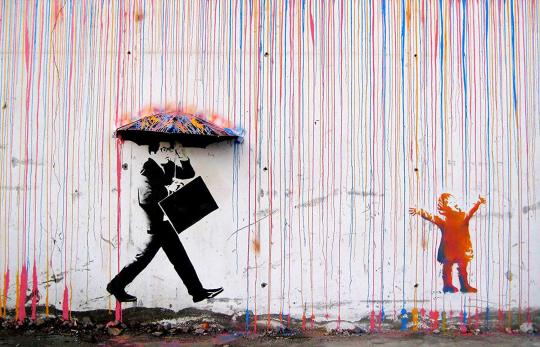
Most of the pieces I saw weren’t very eye catching but the message that some sent were very deep. After the trip I noticed that some people do graffiti in order to be heard, instead of just keeping everything to themselves they express their emotion through public art. I found that interesting because the thought of creating certain pieces in order to get their voices heard just never came to me, it was a total shock. On my free time now I make an effort to find new pieces of graffiti either online or as I’m walking outside and when I find a piece of graffiti I make it a goal of mine to attempt to guess the meaning behind it, I never know if I’m right or not because I can’t ask the artist but it is fun either way and keeps my mind thinking.
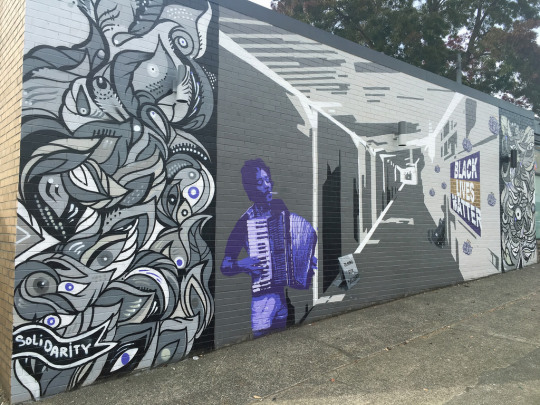
This course has really helped me to try and keep my mind opened and view more than one side on things, especially public art, before I would see a piece of graffiti and continue with my day but now I take the time to try and find the hidden meaning behind it all. I find that by doing this it keeps my mind working and can help relate to certain things. I think that people should give to a try as well, instead of turning away from it pretending it isn’t even there. Some pieces can really be meaningful and can be relatable as well, by making an effort to try and discover the true meaning behind graffiti it can really help the mind stay opened to new things. In the end, you can really find some very cool and deep pieces of art if you put your mind to it.
2 notes
·
View notes
Text
New Perspectives
Throughout this semester, my perspectives on graffiti have changed drastically from what they were.
Entering this course, I did not really know what to expect. My perception of graffiti at the time was that it was pretty much always done by teenagers being rebellious, and that the range of graffiti from tags to intricate pieces simply depended on the skill and time used by the artist.
I don't think that I was closed-minded towards the concept of graffiti as I would appreciate it when I saw it and it was done well, but I never really went out of my way to gain a better understanding of its uses as an art form and the ways it can spread powerful, impactful, and positive messages.
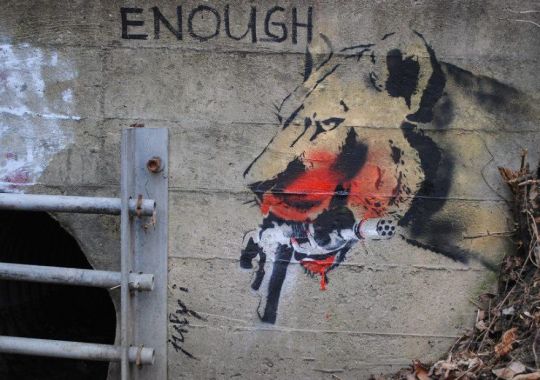
(Image from https://www.architecturendesign.net/40-powerful-street-art-pieces-that-tell-the-uncomfortable-truth/)
I think one of the more profound aspects pertaining to graffiti that I’ve learned over this semester is that it provides artists with a platform to become more well-known, and to spread a message to a wide demographic of people. I never really thought about this prior to taking the course, but art being displayed using graffiti rather than a different medium will typically be a lot more accessible to many more people. Having it out in the open where thousands of people might walk by it per day is a completely different platform than being hung on a wall or posted on social media. In an interview my group conducted with the owner of the Red Brick Cafe, we learned that many of the people who practice graffiti are artists using the medium as a stepping stone to become more well known in their community, and show their skills to a large crowd, in a sense advertising their skills.
When Arthur came in and talked to the class, I also learned that graffiti can be used as a medium for people to express themselves creatively, who may not have the resources to without it. I think for this reason alone it's hard to agree with the negative connotations surrounding graffiti and assumptions that it is always vandalism. Knowing this, and the ways that other cities deal with this controversy, I think they should make an effort to allot certain places for graffiti to be practiced so it does not negatively impact building owners.
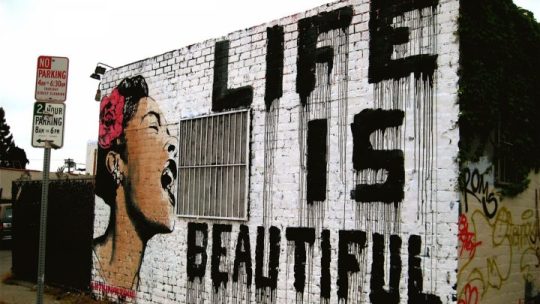
(Image from https://www.hoxtongallery.com/street-arts-with-powerful-messages/)
Since the semester started, I have found myself being a lot more aware of the different forms of graffiti and places where it exists around me. Before this semester, I do not recall noticing graffiti and thinking about it further very often. Now I notice it very frequently, and sometime make an effort to notice it, and when I find it I think about its context, what message its delivering, and how that particular piece may have an impact on the community. I think that this is something that I will carry with me whenever I continue to see graffiti in the future, and that I may become more involved in the informal public art scene if I decide to move to a city where it is more widely accepted.
1 note
·
View note
Text
I really like your idea and I think that it would be helpful to a lot of students on campus because I know a lot of people stress about whether or not their program or school was the right choice for them. I think there is a lot of pressure put on students from the time they are in high school to decide on their future and follow the typical timeline of education, career, family, etc. I remember in highschool when it was time to apply for universities I was still pretty unsure about what I wanted to do. I think that being in school you can kind of feel like your options for your future become more limited as time passes and like everything you need to do should be in a deadline, so putting up messages like the one you suggested would help open students eyes to see that they do not need to feel like they are put in a box. Do you think that alongside the stencil there could be a bit more to reach out to students who may be in this conflict? Maybe there could be resources with it to academic counsellors or guidance counsellors so the students know there are people they can talk to to help them if they need advice?
Prompt 5 - You Don’t Have to Know it All Now
In my time on campus so far, I’ve noticed similar concerns coming up over and over again in conversations I’ve overheard, as well as ones I’ve had with my friends and peers. Repeatedly, I’ve heard variations of people wondering whether or not they’re in the right program, if they’re making the right decision, or if they should be in university in the first place. I’ve seen people panic about failing a course, having to do extra semesters, and not completing school at all. It seems like people feel some sort of pressure to figure their whole lives out now, or to have some grand master plan. They feel like they can’t make mistakes or figure things out now, or they will ruin their whole future.
I think that one message that people at the University of Guelph really need to hear is that there is no one “right” way to live your life that everyone must follow. There are so many ways to be happy, and what is right for one person might not be right for another. University might be what gets you where you want to be, or it might not. Maybe the program you choose will lead to a career that you love, or maybe it won’t. Either way is fine. It’s okay, and very common, to have multiple careers over the course of your life, and what you choose now doesn’t lock you into one future forever. And most importantly, it is completely fine not to know what you want or where you’re going yet. There are so many ways to be happy in life, as long as you work hard and pursue the things that are important to you, things are going to figure themselves out.
One way I think graffiti and informal public art could be used to communicate this message would be using small, subtle stencil pieces. I was talking in my previous post about how I appreciated art that was not obnoxious, but rather was simple, and made its point creatively. The audience would obviously be the students at the University, and therefore it would have to be somewhere students will be spending their time in order to be seen. I think any time is an appropriate time for this message, since people will be having these doubts at any point in time. However, the message might be especially important during midterms or other times when the going might be tough.
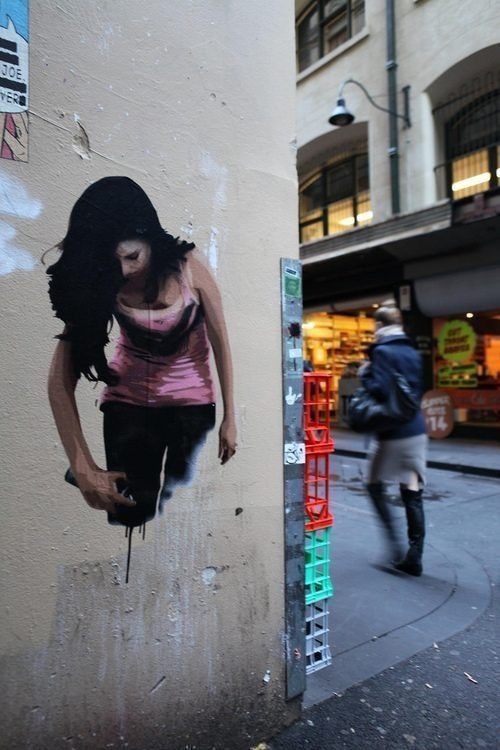
(Image found at https://www.pinterest.ca/pin/559009372467029640/?lp=true )
The message could be something simple, a short sentence like “you don’t have to know yet”, or something along those lines, with a meaningful image, similar to the one pictured above. The image is depicting a girl painting herself onto the wall. The message here is that life isn’t about finding yourself but creating yourself. An image like this one would be simple but impactful. A piece like this could help tell students that it’s okay just to enjoy life and trust that things will work out as long as they work hard and pursue what makes them happy.
4 notes
·
View notes
Text
Graffiti for Mental Health
According to CAMH (The Centre for Addiction and Mental Health), 1 in 5 Canadians will experience a mental health or addiction problem for any given year. The age group that is most likely to experience mental health issues or substance use disorders is people of ages ranging from 15-24.
(https://www.camh.ca/en/driving-change/the-crisis-is-real/mental-health-statistics)
Seeing as the age group most likely to struggle with mental health encompasses the wide majority of university student’s ages, it is quite likely that a large percentage of students at the University of Guelph experience mental health issues.
Students are likely to experience mental health issues as many students often feel stressed out or overwhelmed, do not sleep enough, or become discouraged due to grades or workload.

(Image from http://www.queensu.ca/studentwellness/mental-health)
The University of Guelph does have many mental health resources (https://wellness.uoguelph.ca/counselling/mental-health-resources) however due to the stigma surrounding mental health, a lot of students who are struggling may not feel comfortable reaching out for help.
In my residence building, I see a lot of signs around that provide students with accessible resources or ways to de-stress if they are having a hard time. However, people who are not in this building or who do not visit it often may not see the signs and posters and may not know of resources and lifestyle changes that are accessible for them.
I think if there was informal public artwork around the university regarding mental health, it would be beneficial as it would be seen by many more people, and help raise awareness of issues going on in campus. This would give students a way to talk about mental health, which could help end the stigma surrounding the issues and possibly lead them to be more comfortable talking to their peers about it.

(Image from https://fontsinuse.com/uses/16128/uokm8-campaign)
A pretty simple way this could be implemented on campus would be to have messages regarding well-being or mental health resources posted on the message board beside the Bullring. Being a pretty central area on campus, there is a lot of foot traffic there and the messages would be seen by many students. This could be done using paint or spray paint, or through the use of posters and stickers, similar to the photo above.
These boards are changed pretty frequently, but seeing a message can resonate with someone for much longer. If someone were to see the sign when they are having a bad day, it could help their situation a lot.

(Image from https://salud-america.org/murals-with-a-message-bring-hope-in-mental-health-campaign/)
I think if this were to be done during exam time it would be the best, because although people can struggle with mental health on any day, exam times tend to be the most stressful times for most students.
This initiative would give artists on campus a place to practice their artwork without facing negative repercussions, while spreading an important message to other students at the university, and starting a conversation that needs to be heard.
3 notes
·
View notes
Text
Hi Marin!
I loved your post and I agree completely that using the “Little Free Libraries” is an inclusive concept of informal public art, and that it is uplifting to see these being used to help build the sense of community in a neighbourhood and encourage others to read.
Seeing your post on this resonated with me because when I would walk to work, there was one of the library boxes on my way, decorated nicely with vibrant colours. When I first saw it, it was really heartwarming and I wished that there was one in my neighbourhood when I was younger and had more time to read for leisure. I stopped and read the titles of the books, and every time I would walk by I would scan over the titles and see if there were any missing books or any new books - I was surprised to see that they changed pretty frequently! This was a positive aspect of the neighbourhood that they have it in because there are a lot of younger families that live there and likely make use of the box.
I think if there were more initiatives like this one to use informal public art to bring a community together and possibly help those who need it, there would be less of a negative stigma towards the concept of informal public art, and that it would help the people who are against it in general see the positive aspects it can bring to a community.
Cute Art for Cute Families in Cute Places
A form of informal public art I find particularly provocative would be the Little Library Project that has be adopted around the world, including my own city, Ottawa. It might not hold this title across the globe but the concept is exactly the same wherever you go, a sweetly decorated box is displayed in a residential neighbourhood or maybe even in a more industrial area, holding books to be exchanged and later read. The concept is similar to the take a penny, leave a penny idea. A project like this might not be what people immediately think of when coming up with examples of informal public art but I think the whole idea is that it’s subjective. A lot of effort is usually put into the decoration of the display cases, adding a sense of wholesomeness and friendliness to the surrounding community.


The look like they came from a fairy tale!
I like the way they are engaging to kids as well as older people, I think informal public art should always be this inclusive. It might seem as though this is more of an initiative to get people to read more than informal public art but I think it’s both. They’re put in areas of high foot traffic and have a specific aesthetic quality. They’re also not a government-official city art project with a specific structure and function related to city “success”. If an area wants something to foster community and stimulate residents visually and later intellectually, they just drop one down so long as its welcome by the property owner.
The effect these little libraries have on me and I’m sure others, is a heartwarming and generally uplifting experience. When randomly coming across one on a walk or commute, I always smile and look inside. I don’t usually have anything to exchange but it’s always nice to see what new or different that day. They’re just one of those things that make a neighbourhood a little extra welcoming and community-oriented.

This one is from a neighbourhood in Ottawa I visited often. It’s one of the things all the families in the area are connected to and appreciate. This neighbourhood is known for its especially strong community, they have events like dances, organized charity initiatives and sporting events all within the one area. I think little things like this really contribute to the reputation.
It’s really an opportunity for an artist to clearly communicate with a group of people through the decoration of the display. Whatever they want people to feel when they come across it, people probably will. Bright flowers, images of peace/love or nature are all things that will take people’s minds off of any negativity they might be thinking of or struggling with.

This box really illustrates a particular artist’s style, an almost cartoonish illustration, showing kids playing and what looks like two friends talking about their days. This one is in the UK so they really are all around.
I think everyone can appreciate these instalments but I think they would resonate more with families with young kids because they are the ones typically out and about during the day, experiencing things like this that neighbourhoods have to offer.
2 notes
·
View notes
Text
Graffiti on Global Issues
cli • mate change
noun
a long-term change in the earth's climate, especially a change due to an increase in the average atmospheric temperature.
(https://www.dictionary.com/browse/climate-change)
Climate change is an issue that affects everyone across the world; it is seen in many forms today through the epidemics of wildfires, drought, and intense and frequent tropical storms.

(Image from https://climate.nasa.gov/effects/)
This global issue has been regarded with controversy as many people believe that it does not exist; however recent studies have proven that it is imperative that our society makes a drastic change in order to avoid catastrophic damage to the Earth. The research mentioned in the following article suggests that by 2030, the planet will rise 1.5℃, which will lead to an increase of food shortages, wildfires, drought, and floods in countries across the world.
https://www.cnn.com/2018/10/07/world/climate-change-new-ipcc-report-wxc/index.html
Some of the causes and effects outlined by recent research are highlighted in the following video:
https://www.youtube.com/watch?time_continue=5&v=Yvkm9t7xRF4
youtube
This issue leads me to a piece of provocative graffiti that deeply resonates with me, as I believe that it delivers a powerful message, through a simple statement:
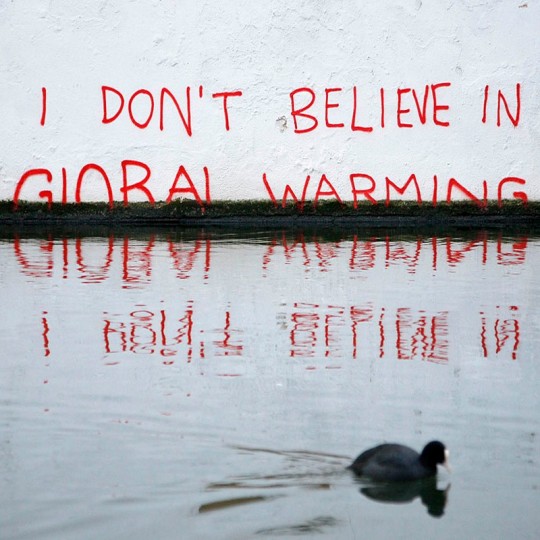
(Image from https://amandamcly2.wordpress.com/category/graffiti/)
This image is very powerful, as it has the phrase “I DON’T BELIEVE IN GLOBAL WARMING” sprayed on a wall where the message is cut off by what appears to be a flood, and which is a well known attribute of global warming/climate change.
I believe that this piece of informal artwork could be very impactful to people seeing it in person or online, as it reminds them of the dangerous impacts of climate change that are often overlooked due to people who are uneducated or ignorant to the crisis.I think that if people were to see this piece of graffiti, it would inspire them to think deeper about climate change and its impacts, and possibly regard their own lifestyle in a different manner to see what changes they can make in their own lives to help make a difference.
Seeing this photo had a personal impact on me because I have lived in Ontario for my entire life, and we do not often see the issues regarding climate change first-hand. Living in Ontario, I have remembered having hot summers and cold winters every year, and have never been drastically affected by wildfires, floods, tropical storms or droughts. When you do not deal with an issue personally, it is easy to forget that it can be a life changing one for someone in a different living situation.
In the past few months, I have seen more and more articles and news pertaining to the detriments of climate change that are happening right now, and it really opened my eyes to the issue. Seeing this photo furthered my knowledge of current climate change issues, and I think if more people in situations similar to mine were to see it, they would also feel more informed and inclined to do more research.
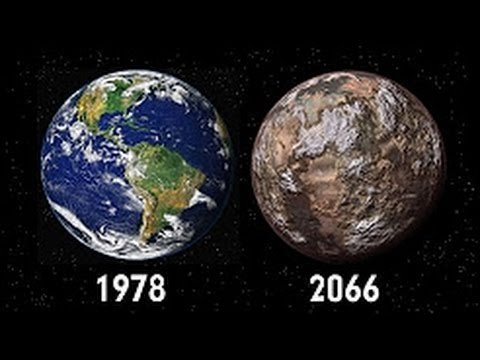
(Image from https://www.youtube.com/watch?v=hB4I9xV67Mc)
0 notes
Text
Hi Justin!
I really enjoyed reading your post and you definitely put a lot of thought and research into your points and their support.
I agree that a lot of the people opposed to graffiti in Guelph would be parents of young children as well, likely because they would not want their kids to see any negative messages, or vulgar words or pictures in their city. Maybe this could also be because they would not want their children to see graffiti and get involved in it themselves, since there can be negative repercussions with the law?
You mentioned that the city of Guelph only cleans up graffiti that is considered hate graffiti, and that it is volunteers that clean up graffiti that is considered meaningless. The classifications for graffiti that is cleaned by the city are pretty specific, but it seems like the graffiti that could be considered meaningless and that is cleaned up by volunteers is more so based on the opinions of the volunteers themselves unless they are given input from their community. I understand why and agree that meaningless graffiti that does not need to be there should be cleaned, but I think that this could be a flawed process because there could be meaning behind the graffiti that might not be as clear to someone at first glance.
Your initiative is a really great idea and I think that it would really help people who are either opposed to or uninformed about graffiti help gain a stronger understanding of how it can benefit a community!
Good vs bad and what is seen as value in the community with respect to Graffiti
I believe parents of young children and elders are opposed to most forms of graffiti. However, I do believe it depends on the message in the graffiti as well as the artistic feel of the piece. Based on personal experience I believe that murals and really detailed pieces of graffiti are supported by almost everyone. What most people do not like is messy graffiti work and or tagging. I believe this is why there is such an effort to clean up graffiti in the city of Guelph. If you search “who is opposed to graffiti in Guelph?” on google the first site that pops up is a city of Guelph site. In this is a reporting area where you can report graffiti that is a hate crime, vandalism, or offensive graffiti. Based on my understanding of the definitions provided by Guelph municipality graffiti is only considered bad and will be cleaned up if it meets one of the following: “Hate graffiti is motivated by hate, bias or prejudice, based on race, nationality, ethnic origin, language, color, religion, sex, age, mental or physical disability, sexual orientation, or any similar factor.
Vandalism based graffiti includes writing, painting or etching a symbol or “tag” that may or may not contain letters and is not considered offensive or hate based graffiti. Offensive graffiti is generalized as being obscene or offensive in nature such as but not limited to, swear words or sexual drawings and is not hate-based.
Graffiti is addressed on a daily basis from May 1 to Labour Day. Hate and offensive graffiti removal are addressed as a priority task. If vandalism or graffiti is currently in progress please call Guelph Police at 519-824-1212.”
https://guelph.ca/how-can-we-help-you/graffiti/
Because people do not enjoy these tags and other forms of graffiti that are essentially meaningless they would like them removed and would prefer to not see them around. This is seen through volunteer programs that go around and paint over the graffiti.
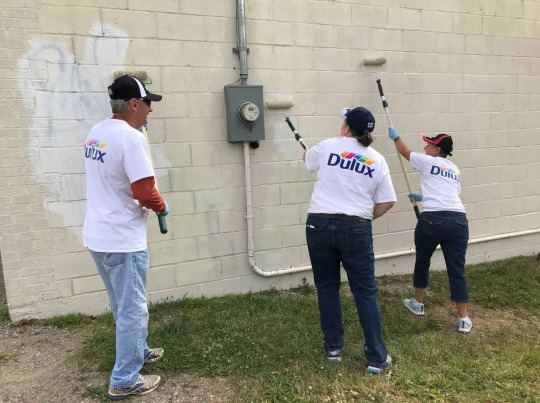
https://globalnews.ca/news/4290848/guelph-graffiti/
In the article above we can see how people are opposed to tagging and graffiti that is meaningless and doesn’t hold value to most people in the community. In this article, it mentions that Paul Deacon who started this program says “about 80 percent of the buildings they worked on in 2016 have gone untouched”. What this says to me is that the group in which painted those tags or whatever on the sides of those buildings came to an understanding after seeing their work painted over that it was not appreciated in the community and they may have started to realize how useless and pointless those tags were.
My question is what is an artistic drawing in spray paint considered? Is it good ? is it graffiti? Well based on the fact that people are cleaning up all graffiti that does not bring pleasure to people tells me that yes it is good and people find it appealing and do not complain about it. so in a sense, this is where the term informal public art comes from because people want to call it something else rather than graffiti which is associated with the tags and inappropriate words some people spray. Based on the above look at graffiti vs informal public art, graffiti is mostly seen as a bad thing that people do not care to look at and in fact, in most places, it bothers them. This is far different from the value of informal public art as people are willing to pay to have it done as well as it likely will not be removed because of the value that people believe it has.
One initiative to increase visibility and awareness of informal public art could be a tour like experience people would pay for or be provided to them. Similar to a tour of a countryside or a museum, a group of places could be put together that maps out and helps everybody see the importance and value that the informal public art holds in our community. It could even go to the point where there is a bus that goes around every now and then with an expert informal public art curator that is essentially the tour guide to helping people see these artworks. This initiative would also encourage people to talk about what these informal public arts mean and why they were out there. I think at the end of the day this idea of an informal public art tour ultimately would get people talking and thinking about what the art installers wanted from different pieces. I believe it would engage the community in a way that would hopefully get people trying to create solutions to problems in the community as well as a new understanding for informal public art.
This initiative idea is similar to one that existed during the Guelph jazz festival but I believe if it was expanded it would meet what I am describing above.
Below is a photo of a street artist Arthur Kerrey talking about a mural by Guelph artist Meredith Blackmore
“The free “Street Art Walk,” organized as part of the Guelph Jazz Festival, was led by local street artist Arthur Kerrey.
Kerrey began the walk at Market Square, providing a brief history of graffiti art for the roughly 15 tour participants, highlighting the art form’s roots in hip-hop culture, before taking people to see the wide variety of street art examples the downtown has to offer.”
https://www.guelphmercury.com/community-story/8904197-guelph-graffiti-gallery-photos-of-street-art-from-downtown-street-art-walk/
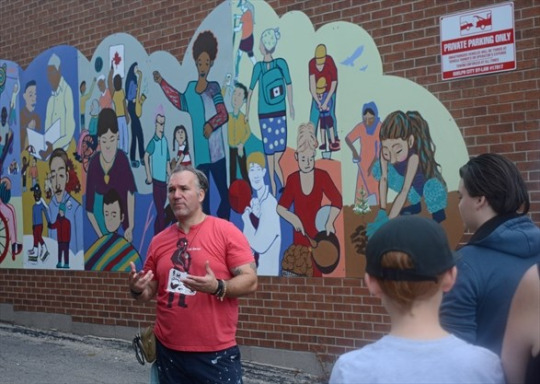
1 note
·
View note
Text
The Opposition and Support of Graffiti in Guelph
Guelph is known to be a “Clean and Green” city; as it is one of the few cities in Ontario that is primarily recognized by its commitment to the environment, through the use of sustainable energy sources.
(https://www.partnersinprojectgreen.com/news/city-of-guelph-leading-ontario-in-renewables-and-energy-efficiency/)
Due to this major focus on environmental sustainability and the vast population of citizens being either passionate about the environment, or employed in the green energy sector, I believe that the citizens of Guelph who are most opposed to graffiti within the city are those who are environmentally conscious, and are concerned of the impact of graffiti on their city.

(Image from https://www.partnersinprojectgreen.com/news/city-of-guelph-leading-ontario-in-renewables-and-energy-efficiency/)
I think the most widely identified form of informal public art work is that done using spray paint, as it is seen nearly everywhere. According to https://graffitiinthenaturalworld.weebly.com/how-does-graffiti-impact-the-surrounding-environment.html, the use of spray paint emits toxic fumes into the air, which can add to ground-ozone levels, and further affect global warming. It is mentioned that the substances used to clean graffiti off walls can also be dangerous for the environment.
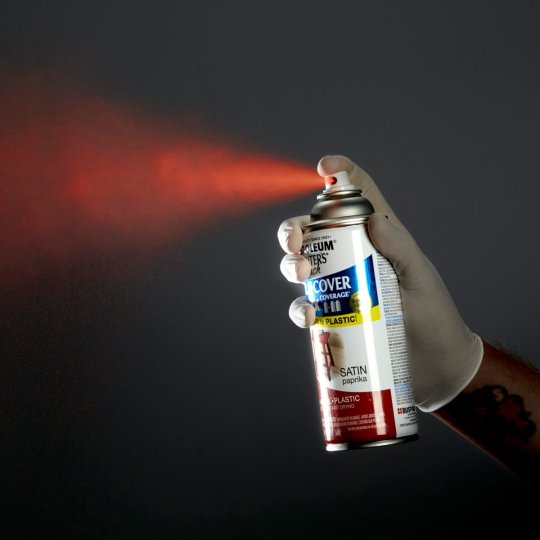
(Image from https://www.familyhandyman.com/painting/12-tips-for-perfect-spray-paint/view-all/)
It is possible that this demographic in Guelph could be opposed to graffiti because people who practice graffiti have been known to spray trees, where it cannot be removed. According to the following article, this is a major issue in San Francisco, as it has been proven that younger trees can be killed by the chemicals in spray paint.
https://www.nytimes.com/2011/11/18/us/graffiti-taggers-turn-to-trees-with-some-possibly-harmful-effects.html

(Image from https://www.centralmaine.com/2013/07/03/vandals-defile-hallowells-vaughan-woods/)
I believe that the people who are supporters of graffiti and informal public art within Guelph are the artists looking to share the positive impacts it can have within the community. The following article mentions that several supporters of graffiti within the city of Guelph are trying to display the informal artwork in a way that exhibits how graffiti can bring art to a community.
https://guelpharts.ca/about-us/news/171-street-art-is-not-graffiti-a-look-at-the-bigger-picture.
One place that is mentioned in the article and that is on my group’s bus route is the Red Brick Cafe; whose owner is an artist that commissions graffiti artists to display their work on the side of her store to demonstrate to the people who are opposed to graffiti how it can be a positive aspect of a community.
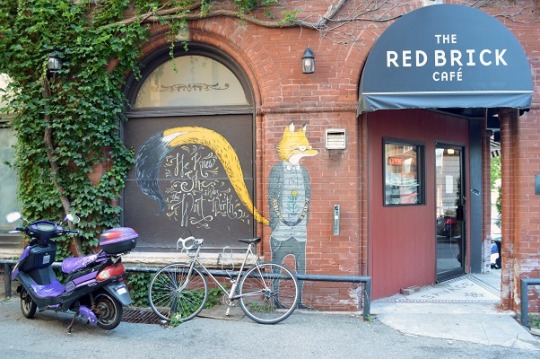
(Image from https://guelpharts.ca/about-us/news/171-street-art-is-not-graffiti-a-look-at-the-bigger-picture)
I think an initiative that Guelph could take to increase the awareness of graffiti and public art is to hold a public art show where graffiti artists could exhibit their work for the community to see. Since this would have to be done in a way that does not deface walls of those who are not okay with it, false walls could be made in a public area with scrap and recycled materials for the graffiti to be practiced on.
These walls would otherwise not look visually pleasing because they’re made of scraps, but since graffiti would be on them, they would be aesthetically pleasing so people could see how public informal art can contribute to the community. This would cater to the people in Guelph who are against the graffiti for environmental reasons, as pieces of scrap materials that would otherwise be in a landfill are instead being used to create art. This would also benefit the people who support graffiti because it would help inform the community of the beneficial aspects of street art in a positive way.
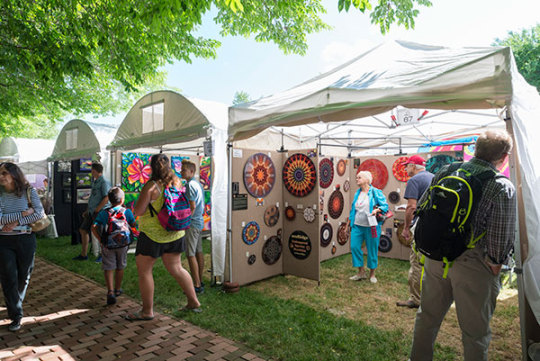
(Image from https://www.chicagobotanic.org/artfestival)
0 notes
Text
Hi Marin!
I loved reading your piece on the graffiti and street art you've seen in Ottawa, it was super well written.
I think it is really cool that there is such a wide variety of street art that you've seen there, and that it extends so much further than spray painted tags and pictures, which is what often first comes to mind when people think of graffiti.
I don't think that I have seen yarn bombing in my city before, but I think that it is really interesting and that it brings a lot of visual variety to the city because it is something that you do not see often, and it shows how you can use different mediums through texture and colour to make something look completely different. It is also so nice to see that people can use their skills through street art to help others in their city that may be struggling, while bringing some new looks to the area they choose.
It's sad to see that people choose to do hate messaging through graffiti, as you have shown how you can do so many better things with street art. It is good though that Ottawa is diligent on making sure that the people who put up the hate messages are found and learn that it is wrong.
I agree with what you said that the intention behind the graffiti is what distinguishes the graffiti from being vandalism or artwork. I think when art is being practiced in a public place, it is even more important that the messages behind it are positive or important ones.
Yarn, Mini Pizzas and Hate Crimes
Ottawa is a city with a pretty decent arts scene, we have the National Arts Centre, the National Gallery and many smaller-scale groups and organizations. An interesting aspects of the city however, is that we do not have much informal public art, much of the art you see along the streets is supposed to be there. We have statues, murals, even street corners with protected speakers to be constantly playing jazz music.
I’m not sure what started this, but Ottawa is actually fairly strict in terms of dealing with “things that aren’t meant to be there”. Whether it’s graffiti or statement pieces or randoms acts of spontaneity. An example is the time it became prohibited to lay flower petals along the sidewalks of one of our wealthier neighbourhoods. I’m not sure who became offended by seeing flower petals, outside, but I was not involved in the situation so I don’t have these answers. We have an intense graffiti removal program run by the police department, that could be in response to the three legal spaces for graffiti. Since there are the allotted walls they must feel justified removing all other occurrences of graffiti.
One instance of informal public art that we have seen in Ottawa is equally artistic as it is charitable. Yarn bombing has been seen around the world, in many different cities including Lethbridge here in Canada, NYC and even Dresden in Germany. It isn’t always used as an act of kindness, sometimes just for the visual appeal. Yarn bombing is known as the act of covering objects or structures in yarn as a form of street art. Here are a couple examples, not from Ottawa:
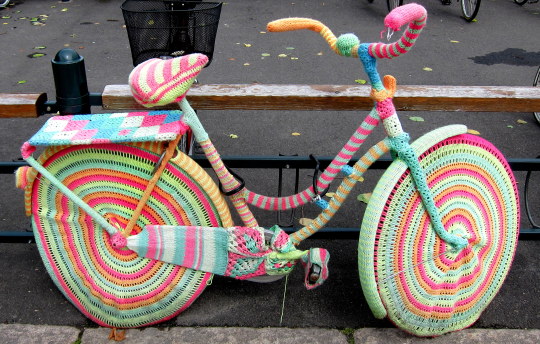
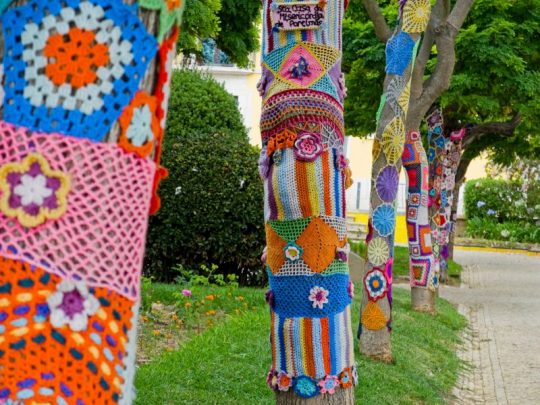
The way it has been used in Ottawa is as an act of generosity and charity. A group of older women had a little knitting club that met regularly. Eventually they decided to put their projects to good use. They took their items and draped them around our city’s most famous statues including Oscar Peterson, Terry Fox and some of Canada’s past political figures.
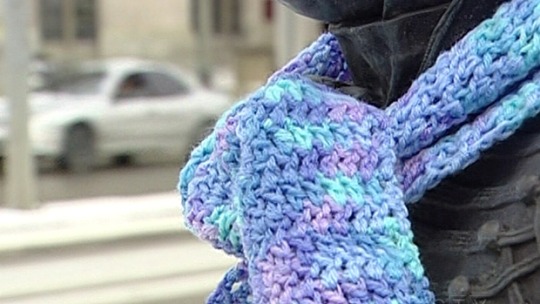
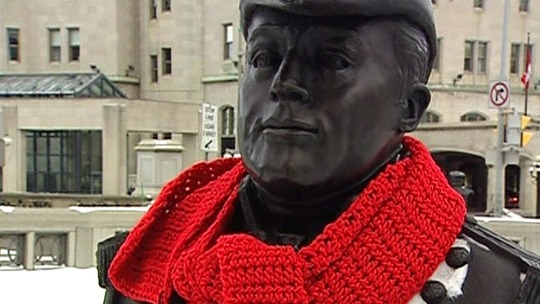
The women left notes on the apparel stating they were free to take if needed since it can be really dangerous to live outside during the winter months. If the items aren’t taken, it just looks like someone is trying to keep the public figures warm.
Another instance of informal public art we have in Ottawa is from an anonymous artist who is active on Instagram. This artist leaves miniature clay sculptures in cracks and crevices around the city, with the intention of bringing joy to the people who see them.
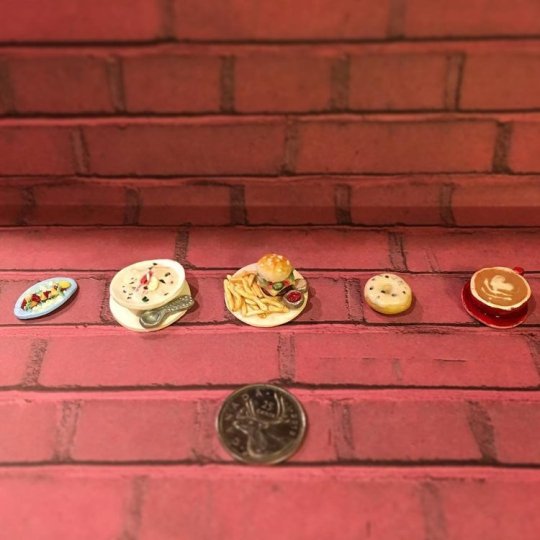
These two examples of informal public art in Ottawa show that it can be done by any part of the population, it isn’t one type of person that can participate. The artist responsible for the clay miniatures is most likely young enough to have been exposed to the style and have the dexterity to work with such small materials. The yarn bombers are older women continuing with a form of art that is very traditional. I think this is because street art can be as small or as large as the artist wants. Since it can be essentially anything, any kind of person can be a street artist, it’s not limited to one point of view, one economic class or age group.
The graffiti in Ottawa has been more of a difficult conversation. Due to the opportunities for legal graffiti done by professionals, the graffiti found around the city can be less appealing. An extreme case of this is the hate messaging left on some of our religious buildings.
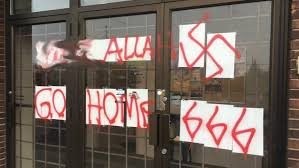
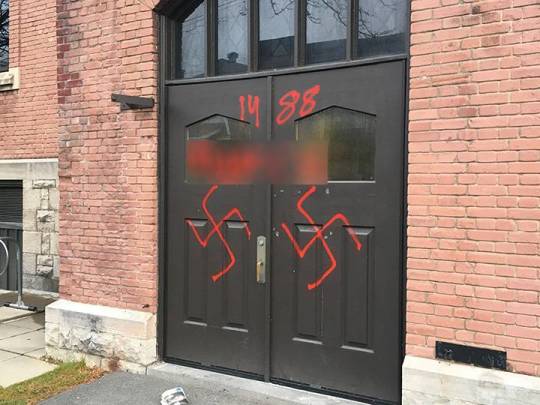
The first image is the building that houses the Ottawa Muslim Association, the second, a Jewish synagogue. These hate crimes were done by teenagers, they were sentenced to three months in custody and made to write essays on the muslim, jewish and black communities.
I think the main difference between street artists/professional graffiti artists and the people who contribute less professional graffiti is intention. Street artists and professional graffiti artists have the intention either to make something visually appealing for people to see during their everyday lives, to brighten people’s days, to provide services/acts of charity or to spread positive messaging.
Those who put up hate messaging or unpleasant images have the intention to spread their anger to others. If they didn’t want to negatively impact the morals of others, they wouldn’t put that types of messaging in public spaces. I don’t think a certain types of person contributes street art or graffiti because it it such an open-ended type of art but I believe the difference is the intention of the artist.
3 notes
·
View notes
Text
Who does it?
In London Ontario, there is a wide array of different types of graffiti, as well as different locations where graffiti can be found throughout the city. This extensive variety of vandalism and street art that all fall under the same category of graffiti leads me to believe that there are several demographics of people in the city that install informal public art.
The first demographic of people that I believe practice graffiti in London are younger teens, who may not be doing it to share art, but rather to try to rebel against the system. This is who I think is responsible for the vulgar words and images spray painted on signs, schools, and throughout skate parks in different neighbourhoods. Growing up, I remember walking throughout the area of my city that I live in and seeing the phrase, “The 9ines” sloppily and slightly illegibly spray painted on lots of walls and fences in my neighbourhood. I remember my friends and family talking about this occasionally, and they seemed to believe that this was a group of kids from the neighbourhood that referred to themselves by that title, and wanted to claim their area in a sense. This type of graffiti was viewed in a negative way, as it didn't have much substance to it, and was often being covered up.
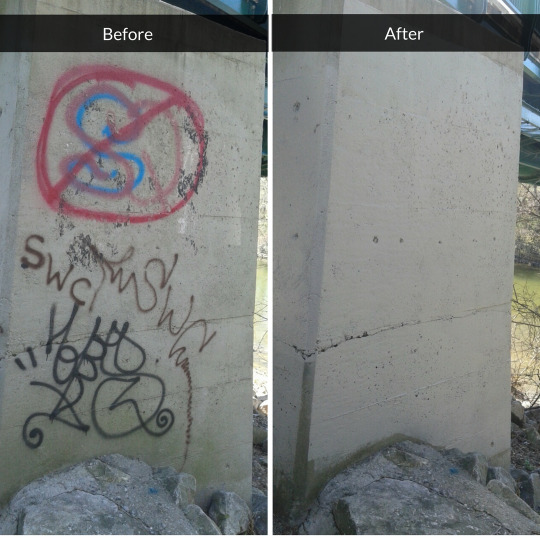
(Image from https://cleanworkslondon.ca/graffiti-removal/)
The type of graffiti from the previously mentioned demographic is regarded in the city quite differently than others. Though London has been known to be a pretty conservative city in the past, I think its views are becoming more progressive, maybe due to the population of University and College students that go to school there. For graffiti that is done in a negative way, whether being the message or its aesthetic, there are serious consequences for the artists being caught. (https://london.ctvnews.ca/london-teen-facing-charges-for-graffiti-in-downtown-area-1.1381086)
Conversely, for graffiti and street art that is done well, the city seems to appreciate it and regard it more as artwork than vandalism. This article mentions that a large group of graffiti artists of varying ages and skills were asked to transform a wall and bring some new looks to the area; https://lfpress.com/2017/06/25/graffiti-artists-both-young-and-experienced-transform-a-store-wall-and-build-community/wcm/6e707d11-f6dd-ae2a-5966-fc9ceacc0f66.
This brings me to the second demographic of people that I believe are the graffiti installers in London; artists who use street art and graffiti to share their art publicly. I think that this demographic of people exist in a wide age and skill range, and are the people who design the murals and paintings on the sides of walls, specifically downtown. This demographic typically does their graffiti very well, either by being visually appealing, or delivering a powerful message to those who take the time to consider it. Whenever I see this type of street art, I often see people stopping to look at it for a while or take photos of it, which is very different from the previously mentioned type of graffiti that doesn't usually get looked at twice.

(Image from https://www.flickr.com/photos/ravensview/sets/72157627009634852/)
2 notes
·
View notes
Text
Hi Kayla!
I loved your post, especially your photography that you included! Graffiti and other street art are great subjects to shoot.
In the Toronto area there is so much cool graffiti to see, and growing up in a family of artists and seeing the graffiti probably allows you to appreciate it a lot more.
About your initial perception of graffiti that you learned from your parents, I think that it really does hold true for a lot of the issues surrounding graffiti. Seeing street art on the sides of buildings that are owned by a city or by a big company definitely allows you to appreciate the artistry behind it, where if it were done on the side of someone’s house (or fence) I don’t think they would see it in the same light.
I think it is super cool that you chose to do your project on street art. I used to do photography, and I think that you can really appreciate things or places on a different level when you take pictures of it and notice all of the details that you might overlook if you are just observing. Your pictures that you included are really great, I loved the different angles and lighting you used to capture the street art. The picture of the light posts really shows how people can express themselves using so many different mediums of art, and how it helps cities be more visually interesting!
Prompt #1
Hi I’m Kayla McDougall, I’m a first year student studying Criminal Justice and Public Policies. I went to high school in Toronto but live in Whitby. I decided to take UNIV 1200 because I’ve always been very intrigued by art, even so that before I decided I wanted to study for a career in the crime field I wanted to go for school for photography. My family has always been into art, for example my brother is a very good artist, he’s done graffiti before and now his career is being a tattoo artist.
I feel my introduction to Graffiti and informal public art, was when I was young and I would be in the car with my parents and we would drive past a building and I would see writing all over the building, there was actually this one time, I believe I was in kindergarten and I would walk home with my nana everyday and there was this one house that we would always pass and there was a new fence that got put up. About a week went by and I was walking home and you could see that there was graffiti all over these peoples fence, I feel that day was the first day I was introduced to graffiti. Back then I just saw it as vandalism, because I was very young and I didn’t know that there could be a message behind each piece. I received this perception by my parents, I was always taught to not touch all peoples property unless got permission to do so.
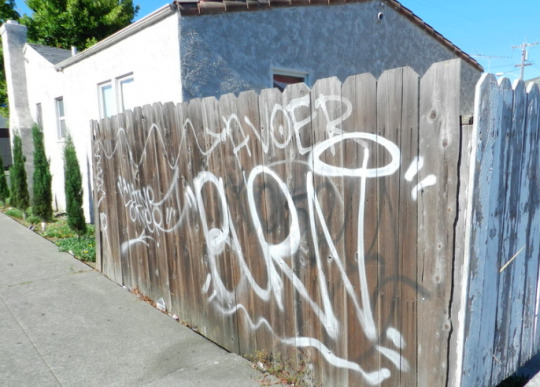
When I got older I found an interest in street art, when I would practice photography I would always tend to take photos of street art, of buildings, storefronts, paintings, graffiti, or sculptures. In grade 11 I took a photography class, and as our final assignment, we had to take several photos of something that you’re passionate about and it had to have a theme to it so, I decided to do my project all about street art, so I went downtown Toronto for a day and traveled all around and took pictures of all different kinds of street art. That was probably one of my favourite projects I’ve done, because when I’m taking photos I feel really relaxed, also when just seeing street art people tend to just walk by like its nothing, so when I was taking photos, I was able to take my time and really look at the pieces and try to understand them.
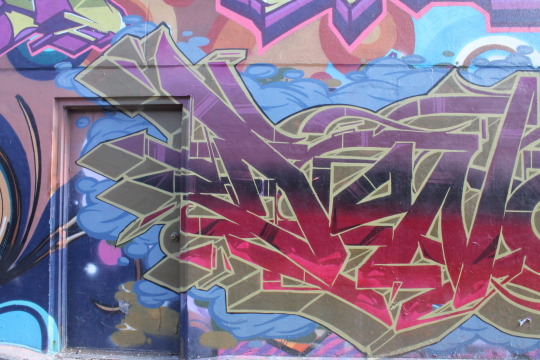
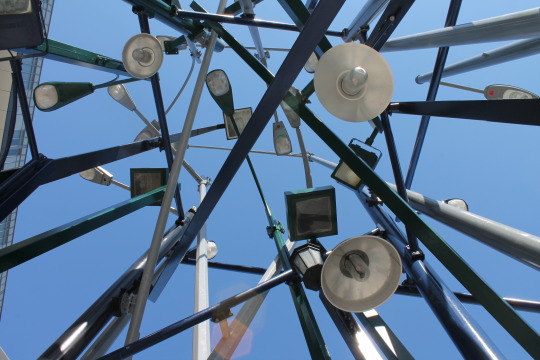
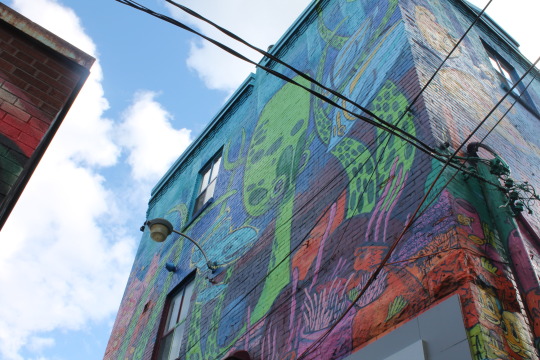
Furthermore, from the time walking home from school to my grade 11 project to now, I have found a greater appreciation for graffiti and informal public art, I feel that really it’s a place where people express themselves and can bring upon a message where everyone can see it. After this semester of this class I my appreciation and knowledge will grow even more then it is now.
6 notes
·
View notes
Text
Hi Rose!
That is so cool that you lived abroad, that must have been an amazing and life-changing experience! I bet that you learned a lot about yourself and about the world by living in a completely different culture than what you were used to, and by meeting people that you otherwise would not have.
It is really interesting about the study you mentioned that showed that people were more likely to litter in areas where there is graffiti. Maybe this could be because when people see the graffiti, they see that someone else has defied societal rules. This could make them feel more inclined to do so themselves, or maybe feel like it’s not a big deal to do it?
I agree with your opinion on the significance of the location of graffiti, that if it is found in a built-up area with man-made things that are not naturally there, it should not be an issue to add to the buildings so long as the content of the graffiti is not distasteful. However I think it might be hard to draw the line of where this should or should not be allowed; for example, a lot of parks have a mix of both man-made and natural structures, which might make it hard to distinguish where graffiti should be practiced.
I really enjoyed reading about your stance on graffiti and how you were able to develop your own opinions on street art, even though you didn’t see it much growing up!
A First Look at Graffiti: The Good, The Bad & the Ugly
Hey, guys! My name is Rose and I’m a first year bio-med student, travel enthusiast and animal lover looking to broaden my horizons and dive into the depths of the art world. I have been science-centered for too long and I’m so excited to bring art back into my life through photography and written topics surrounding informal public art.
Part of what inspired me to take this course was the life-changing experience I had living abroad last year. I spent nine months living with a host family in downtown Madrid, Spain, where I worked as an au pair. The breathtaking murals I saw in Spain and Portugal really caught my attention and made me appreciate graffiti in ways that I hadn’t before. In regards to the rest of my time abroad, I became somewhat fluent in Spanish, made the most amazing friends from all over the world, and grew a lot as a person. I also drank too much Sangria, partied too hard and realized I don’t want kids anytime in the near future. Nevertheless, I went into the experience blindly, not knowing a soul, and I could not have been more rewarded. It was the best year of my life.

Back on topic…
My first introduction to graffiti art was sidewalk-chalking the hell out of my driveway as a toddler. This was encouraged by everyone in my family-friendly neighbourhood (but then again, it was temporary). Later, in primary school, my friends and I would write our names or doodle on school walls, bathroom stalls and the insides of our desks. I don’t remember ever getting in trouble for it, so I wasn’t aware of the concept of vandalism. My self-made “graffiti” was very innocent and just for fun.
Typical graffiti art wasn’t prevalent in my neighbourhood so I didn’t have many preconceived ideas about it. My mom once told me about a study where people were more likely to litter in graffitied areas, so I saw graffiti in a negative light for a little while because of that. The media likely contributed to my perception of graffiti as well, making it backdrops for edgy crowds of people and making it seem like a place for secretive activity like drug deals. However, I never thought of graffiti as the cause for illegal activity and I didn’t have a strong opinion on whether graffiti was wrong or right.

This leads to my current opinion on the subject. I believe that the vandalism-versus-art discussion has everything to do with the location and quality of the graffiti. In unattractive urban settings, where there isn’t anything to look at in the first place, I see no problem with graffiti (unless it’s offensive in some way). We have already covered the natural land with man-made things and graffiti is simply another man-made thing, though one with character and charm. On the flip side, graffiti done in areas with wildlife or beautiful architecture seems to kind of disrupt the beauty and simplicity of the place.
In terms of quality, I can see how negative quotes and random word sprawling can ruin the mood of an area and be considered vandalism. However, when graffiti is done well, I am absolutely in awe of it. It feels no different than walking through an outdoor art gallery. However, it is always free and available and the fact that it can be done by anyone means it may be more relatable and bear more meaning to the people living in proximity. Just because a painting or poem isn’t in a gallery, doesn’t make it less of a quality piece of art. I’m so excited to find some graffiti “gems” in my city and learn more about the history of graffiti through this course.
3 notes
·
View notes
Text
Graffiti at First Glance (Blog Prompt 1)
Hey everyone!
My name is Kendra, I am from London, Ontario and I am majoring in Bio-Medical Science. Some of my favourite hobbies include spending time with my friends, family, and dogs, listening to music, skiing, and hiking. I also enjoy playing the piano and the guitar.
In London, much like any other city, there is a wide variety of graffiti scattered throughout various alleys and urban canvases. From what I’ve experienced, this ranges from tags and phrases spray-painted on the sides of trains and dumpsters, to poles and street lights plastered with stickers, all the way to intricate murals painted on the sides of buildings.
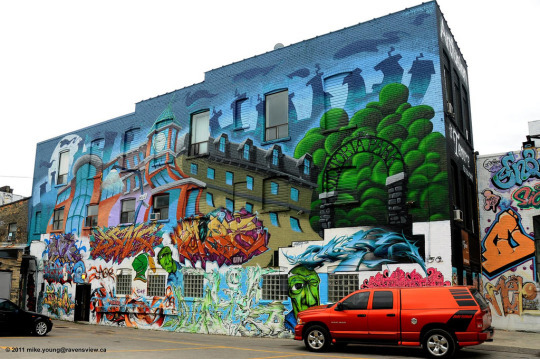
(Image from https://www.flickr.com/photos/ravensview/sets/72157627009634852/)
Growing up, I was familiar with graffiti, but only on the surface level; I was able to recognize and appreciate it to an extent, but I rarely considered its deeper meanings and implications.
Although I had observed it on many previous occasions, the first time I gained a more profound understanding of graffiti and informal public art was when I visited Graffiti Alley in Toronto. Strolling through the small pocket of alleyways and seeing street art that was allowed to be there changed my perception of the concept; I was able to revel in it from a new mindset that was no longer primarily based on the negative connotations surrounding graffiti that I had gained from its societal controversy.

(Image from https://www.tripadvisor.ca/LocationPhotoDirectLink-g155019-d8524783-i150098366-Graffiti_Alley-Toronto_Ontario.html)
Around the same time that I had first visited Graffiti Alley, I began to see more posts of street art from around the world on the internet. Many of the photos that I saw opened my eyes to how graffiti can be used by artists who might not have a platform as far-reaching as others, to make their voices heard. These artists’ depictions delivered powerful messages instead of just simple, aesthetically pleasing or vulgar images.
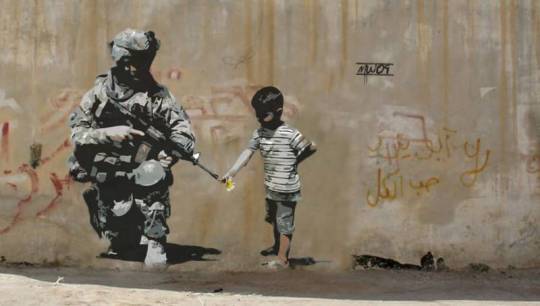
(Image from http://viralpursuit.com/30-powerful-graffiti-art-pieces-around-world/)
When you walk through an art gallery, you take time to appreciate all of the pieces that have been selected for their spots, and ponder the artist’s inspiration, and their purpose for making that piece. When you see graffiti, it is easy to jump to conclusions and classify it solely as vandalism without considering the factors that you otherwise would for formal artwork.. This simple change in setting and artist anonymity tends to sway the audience’s opinion. Regardless of whether the artwork is formal or informal, it is still artwork. Graffiti provides cities with visual variety, and a place to experience art for those who may not be comfortable with or be able to afford visiting art galleries.
Perhaps if there were more allotted spaces for graffiti artists to practice their street art, like Graffiti Alley in Toronto, cities could reach a compromise between those who regard street art as vandalism versus those who consider it as a medium of expression. If more of these places existed, people who do not want to see the graffiti would likely find it easier to avoid, and artists would be able to practice their work without facing the many negative consequences. Furthermore, their art would be appreciated by like-minded observers who genuinely want to see it.
3 notes
·
View notes